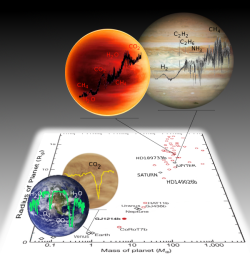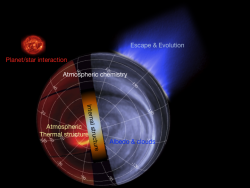The science behind EChO
Scientific Objectives - Information for scientists

Planets can be very similar in mass and radius and yet be very different worlds, as demonstrated by these two pairs of examples. A spectroscopic analysis of the atmospheres is needed to reveal their physical and chemical identities. Credit: EChO proposal team. Click to enlarge
Measure the atmospheric composition, temperature and albedo of a highly representative sample of known extrasolar planets, orbiting different stellar types (F, G, K and M). The sample will include hot, warm, and habitable-zone exoplanets, down to the Super-Earth size (~1.5 Earth radii). Some of the key molecular, atomic and ionic species detectable by EChO between 0.4 and 16 µm at the baseline spectral resolving power are: H2O, CO, CO2, CH4, NH3, H3+, He, K, O3, H-alpha and hydrocarbons. The climate of a planet depends on the amount of solar radiation that is reflected out to space and the amount that is absorbed. Measuring the reflected light from the planet will provide information about the albedo of the planet and the possible presence of condensates and hazes. The combination of visible albedo and infrared temperature will be key to understanding how the energy is redistributed. In the Solar System albedo can range from ~0.05 for the asteroids belt to a maximum of 0.99 for Enceladus, with an average of ~0.3, like the case of the Earth. Photometric observations with MOST seem to indicate that the albedo of the Hot-Jupiters HD 209458b and HD 189733b is very low 1 , suggesting the presence of highly absorbing hazes or clouds.
Measure the spatial (vertical & horizontal) and temporal variability of the thermal/chemical atmospheric structure of giants, Neptunes and hot Super-Earths. The photometric accuracy of EChO at multiple wavelengths will be sufficient to observe the planet not merely as day/night hemispheres or terminator, but to divide the planet into longitudinal slices, hence producing coarse maps of exoplanets (see proposal). Repeated ingress/ egress measurements and phase light-curves for bright eclipsing hot exoplanets will inform atmospheric modelling efforts. This spatial/temporal differentiation is necessary to:
Understand the relative importance of thermochemical equilibrium, photochemistry, and transport-induced quenching in controlling the observed composition. These factors largely depend on the planet's thermal structure, which in turn depends on the planet's orbital distance and metallicity, and the host star's luminosity and stellar type. The host star's chromospheric activity level and the overall UV flux incident on the planet can also affect the photochemistry, but properties like planetary mass or radius play less of a role (see proposal).

Scientific Objectives of EChO. Credit: EChO proposal team. Click to enlarge
Provide much needed constraints for atmospheric dynamics and circulation models. General arguments suggest that planets with orbital periods on the order of a few days are tidally locked 2, 3, 4, so that their permanent daysides are continuously subjected to intense stellar irradiation, while their night-sides may be heated only by a more modest internal energy flux. In the presence of such an uneven energetic forcing, leading to significant (horizontal) temperature gradients, the efficiency of the horizontal heat redistribution is an important open question, as it largely determines their observational properties. Several attempts have been made to address this general circulation problems. Longitudinal brightness maps from the light curve of phase variations, observed by EChO, promise to be powerful diagnostic tools for simulations of hot planets' atmospheric dynamics. Vortices and waves are structures in exoplanet atmospheres that can produce observable temporal variability: these are usually long-lived and evolve with characteristic periodicities 5, 6 which can be captured by EChO's observations (see proposal).
Investigate the complex planet-star interaction. Proper characterisation of a planet's host star is key to the interpretation and to the understanding of planetary data. The star has an impact on two major aspects, i) our ability to measure and interpret the data because of potential sources of systematic errors, and also ii) the modification of the structure and evolution of the planet atmosphere by being the overwhelmingly largest source of energy. Monitoring stellar variability simultaneously with the acquiring of data from which the exoplanet atmosphere will be measured is a key aspect of the EChO mission. Depending on the contrast temperature, our simulations indicate that the visible continuum variations can be a factor of 3-10 times larger than those of the near-IR and mid-IR, thus allowing for proper modelling and subsequent correction of the exoplanet data.
Constrain the models of internal structure. Although EChO will by definition measure the characteristics of planetary atmospheres it will be also crucial in improving our knowledge of planetary interiors. EChO will of course be able to measure with exquisite accuracy the depth of the primary transit and thus the planetary size, but the major improvements for interior models will come from its ability to fully characterise the atmosphere in its composition, dynamics and structure. We give here a couple of examples (see proposal). - Giant planets are mostly made of hydrogen and helium and are expected to always be in gaseous form 7. Because they play an essential role in shaping planetary systems 8 determining precisely their internal structure and composition is essential to understanding how planets form. A large fraction of the known transiting planets are larger than expected, even when considering that they could be coreless hydrogen-helium planets 9, 10, 11, 12, 13, 14. There is thus missing physics that needs to be identified. - Neptune-like planets possess a thick atmosphere mostly composed of hydrogen and helium (several Earth masses). Mass and radius measurements obtained from radial velocities and transit observations, respectively, will not be sufficient to distinguish between this intermediate family and terrestrial planets with a significant amount of water 15. This degeneracy can be easily removed by sounding the atmosphere through primary transit spectroscopy. EChO's observed spectra will allow the atmospheric scale height to be determined, hence the main atmospheric component (i.e. molecular hydrogen or water vapour in this case) and the gravity - the atmospheric temperature is estimated independently by eclipse measurements (see proposal).
Improve our understanding of planetary formation/evolution mechanisms. High resolution spectroscopy will provide important information about the chemical constituents of planetary atmospheres, and this is expected to be related to both the formation location, and the chemical state of the protoplanetary disk. Atmospheric escape is an important factor in the evolution of exoplanet atmospheres, and may define the boundary between Neptune-like planets and Super Earths. H3+ is a key component for the thermal stability of exoplanets: there is a sharp inner limit to the distance a gas giant can be from its star and retain thermal stability. Inside this distance (which is about 0.16 AU for a Jovian sized body around a Sun-like star) the H2 from which the H3+ is made begins to dissociate, inhibiting the molecular ion's formation, thus reducing the cooling effect. The planet responds by heating up enormously with its thermosphere expanding to many times its normal size 16. Our simulations show that EChO's spectral resolving power of ~300 is sufficient to detect H3+ (see proposal).
explore the thermal/chemical variability along the orbit of non transiting exoplanets, especially in high-eccentric orbit. This work was pioneered by Harrington et al. 17 phase curve measurements of non transiting Ups And b. Despite the fact that all planets in our Solar System have a circular orbit, more than 60% of the exoplanets discovered have a high eccentricity, e.g. HD 80606b 18. While non-transiting planets will not be a primary goal, EChO will give us the unique opportunity of studying the chemistry and thermal properties of very exotic objects. On top of that, EChO could:
search for Exomoons. We estimate that moons down to 0.33REarth would be detectable with EChO for our target stars. Whilst Kepler may also be able to detect exomoons, EChO has numerous advantages in that: 1) we target brighter stars so higher SNRs 2) EChO works from 0.4-2.5 µm and can thus obtain NIR light curves which exhibit highly reduced distortion from limb darkening and stellar activity e.g. spots (Kepler is 0.4-0.9 µm) and 3) multi-colour light curves significantly attenuates degeneracy of fitted limb darkening parameters across all wavelengths (see proposal).
identify potential biosignatures in the atmospheres Super-Earths in the habitable zones of late type stars. In addition to the basic parameters described above, which are common to all planets with atmospheres, a planet which harbours life may also exhibit astronomical biosignatures, i.e. the presence of chemically based life on a planet would change the composition of its atmosphere away from the a-biological steady state 19. The study of Super-Earths in the habitable zone of stars cooler than the sun, will challenge the paradigm of the Earth-twin orbiting a Sun-twin as the only possible cradle for life.
References
- Rowe J.F., et al., ApJ, 646:1241, 2006
- Lubow S.H., et al., ApJ, 484:866, 1997
- Ogilvie G., Lin D., ApJ, 610:477, 2004
- Rasio F.A., et al., ApJ, 470:1187, 1996
- Cho J., et al., ApJl, 587:L117, 2003
- Thrastarson H.T., Cho J., ApJ, 716:144, 2010
- Guillot T., Annu Rev Earth Plan Sci, 33:493, 2005
- Tsiganis K., et al., Nature, 435:459, 2005
- Baraffe I., et al., A&A, 402:701, 2003
- Bodenheimer P., et al., ApJ, 548:466, 2001
- Burrows A., et al., ApJ, 668:671, 2007
- Guillot T., Physica Scripta, T130:014023, 2008
- Guillot T., Showman A.P., A&A, 385:156, 2002
- Guillot T., et al., A&A, 453:L21, 2006
- Adams E.R., et al., ApJ, 673:1160, 2008
- Koskinen T., et al., Nature, 450:845, 2007
- Harrington J., et al., Science, 27:623, 2006
- Laughlin G., et al., Nature, 457:562, 2009
- Lovelock J.E., Nature, 207:568, 1965
